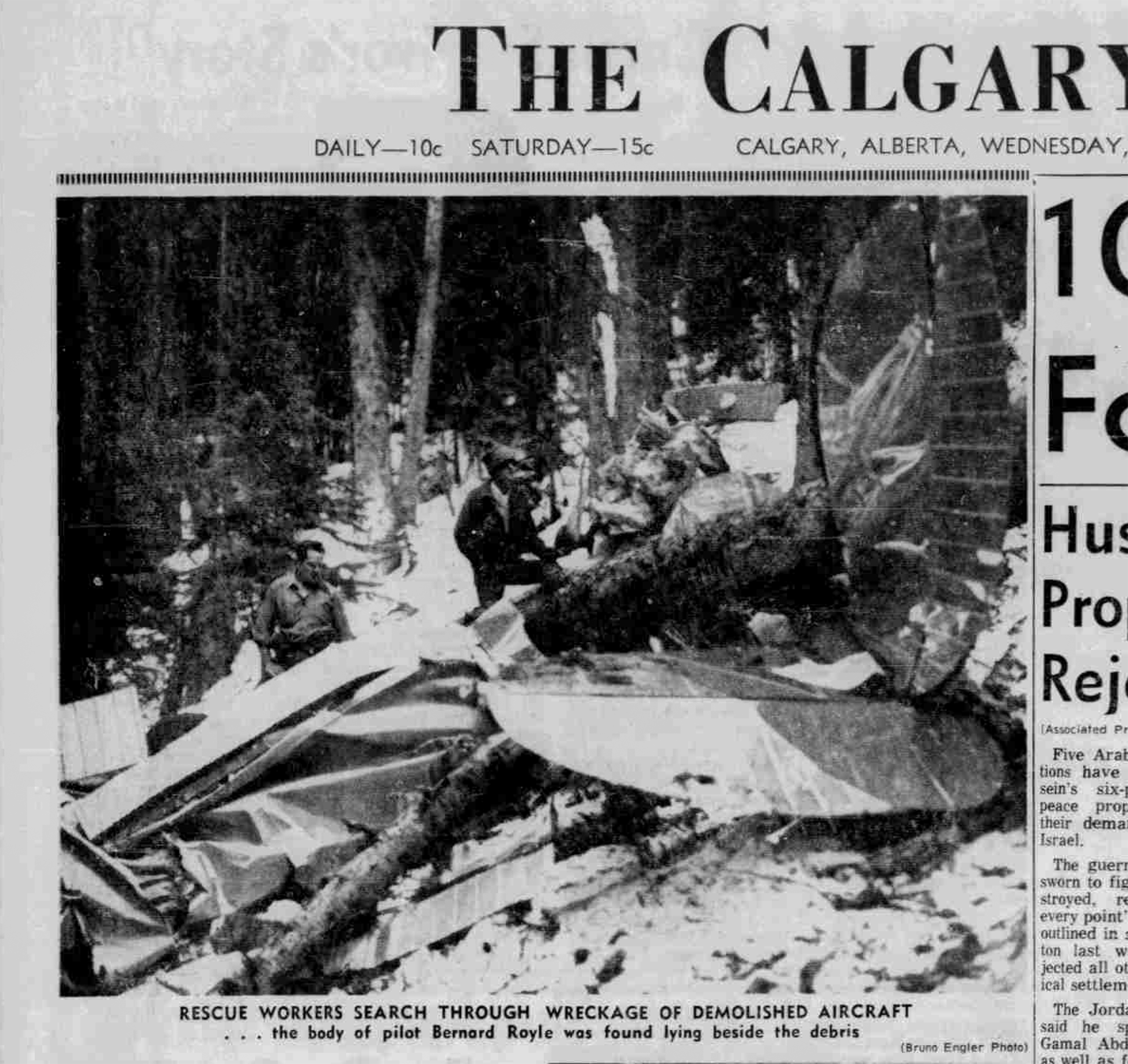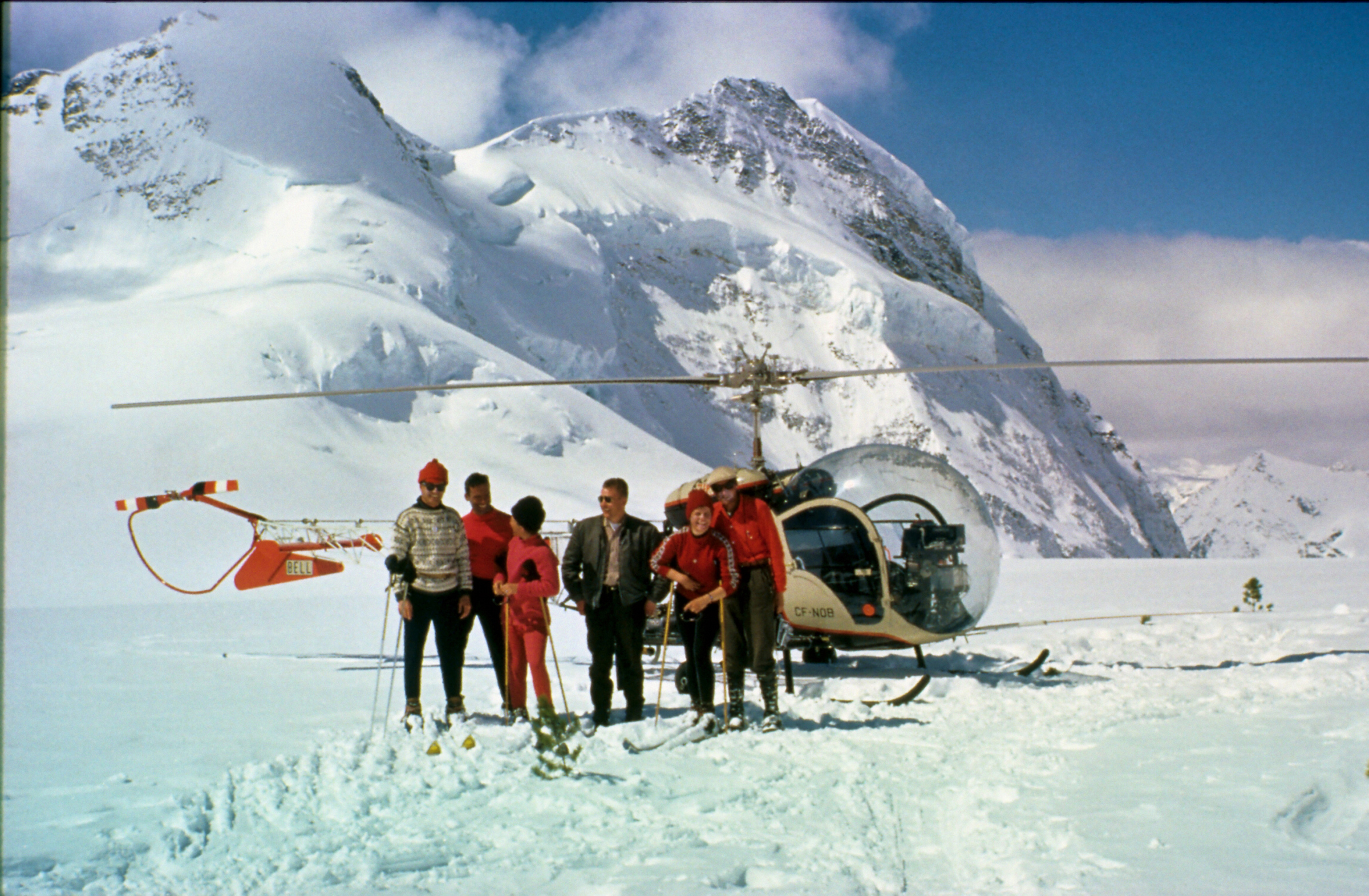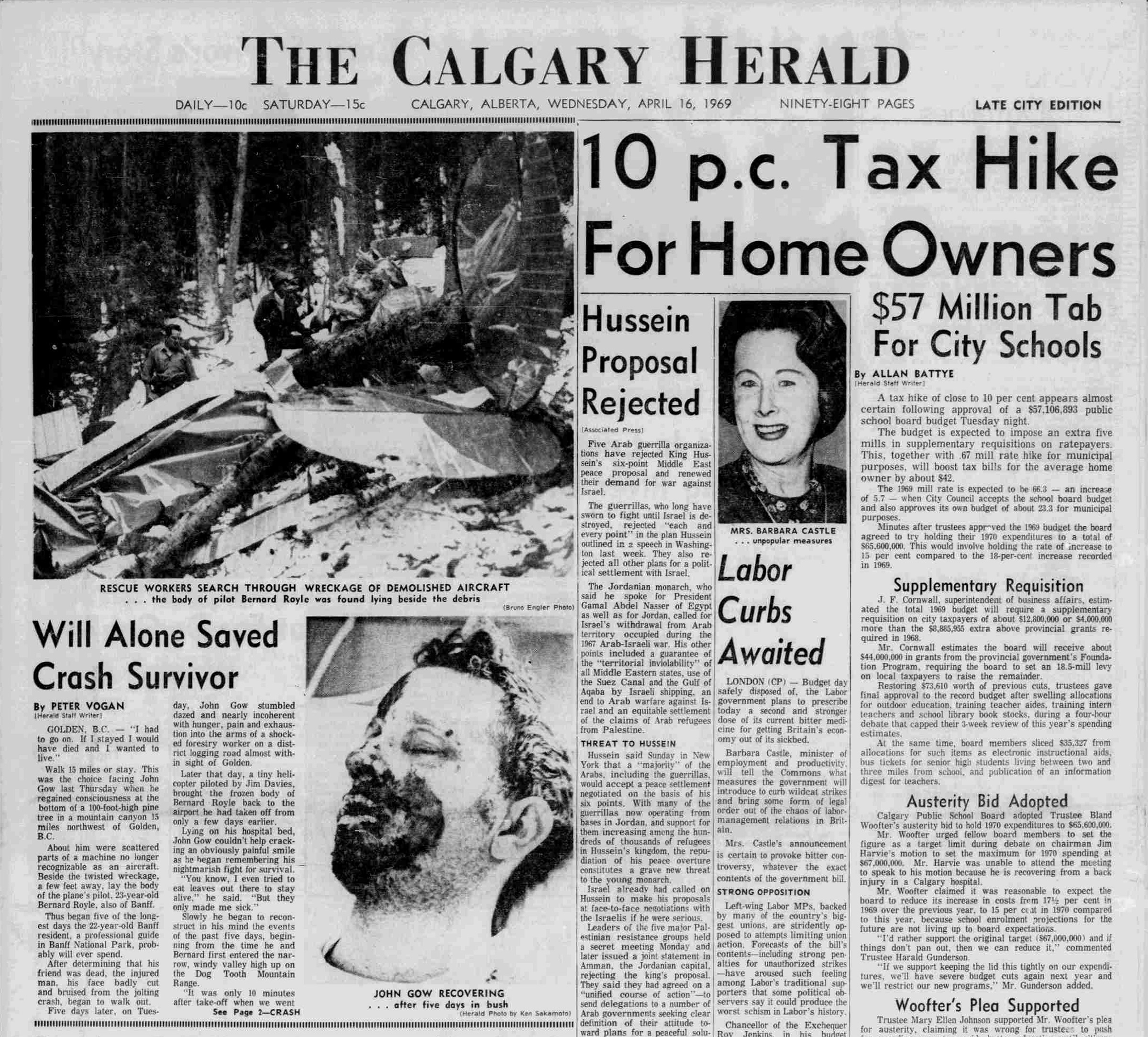
On an early spring afternoon in 1969, John Gow climbed into a Cessna 140 fixed-wing airplane on the runway of the tiny airport in the rural logging town of Golden, British Columbia. His friend Bernard Royle sat in the pilot’s seat, preparing the little plane for flight. The snow-capped teeth of the northern Purcell range stretched out gleaming before them.
In the decades that followed, this rural region would become famous as the world’s mecca for heliskiing: downhill skiing in wild terrain only accessible by helicopter, now one of the world’s most coveted adventure experiences. But in 1969, those mountains represented a vast wilderness, and heliskiing called for pioneers to lead in this whole new sector of skiing—ones willing to accept mortal risk in exchange for unlocking its glory.
Gow and his business partner, Bernie Scheisser, had thus far only been able to take their heliski guests to the front slopes above the great Columbia River. They were reined in by the small Bell B1 helicopter they leased, a cramped plastic bubble that usually served the logging outfits around town. But hundreds of square miles of mountains with unlimited ski potential lay beyond the front slopes, and Gow had plans to get there, in a larger, faster helicopter. To bring those plans to fruition, he just needed to identify the right terrain. The Cessna was the perfect vehicle for a casual reconnaissance mission.
At 22, Gow was already accomplished in the mountains. He and Scheisser also ran a mountaineering camp for youth, he was a high-level ski instructor being groomed to take over management of Banff’s glamorous Sunshine Village Ski Resort and he’d completed his mountain-guide certification two years before. That morning, Gow left his office at Sunshine wearing insulated boots and carrying a down coat. It might be spring in the valley, but it was winter on the peaks, and the weather could change in an instant at this time of year. In the open day planner on his desk, he left a note for anyone looking for him: Gone flyin’.

Royle and Gow flew south along the Dogtooth Range, a subrange of the Purcells, jetting deeper into the wild from three thousand feet in the air, until a side valley cut by Gorman Creek edged into view. Craning his neck, Gow noticed the creek flowed out of a high whitewashed cirque with enormous skiing possibility. He gave Royle the thumbs up. The pilot banked toward the valley.
Suddenly the little Cessna dropped, hitting a stomach-lurching downdraft, robbing it of the speed to clear the mountain wall directly ahead. Royle made a sharp turn to the right to swerve away from the danger. The plane stalled, and plummeted.
Mountain guides are trained to keep escape routes and backup plans in the backs of their minds. But as Gow watched the thick trees accelerate toward them from his seat on the right side of the plane, his last thought was: There is no way out of this.
In 1969, Gow had only one competitor in the heliski business: Hans Gmoser, the Austrian-born mountain guide who had trailblazed this idea of accessing untouched peaks—and their untouched snow—using flight.
Since 1899, the Canadian Pacific Railway had brought Swiss mountain guides across the Atlantic to guide the guests staying at the railway’s famed lodges in Banff, Lake Louise and on Rogers Pass. Those guides laid the foundation for skiing as the winter obsession it is today in this region. When Gmoser immigrated to Canada in 1951, he landed at the tail end of that first phase of western Canada’s celebrated mountain culture, and just in time to effectively lead the way into the next.
At that point, the only way to access the bottomless powder of the backcountry—a coveted kind of snow impossible to find on the crowded resorts—was through ski touring, which required hiking up mountains with sticky mohair skins on the bottom of skis. But in 1965, Olympic ski racer Brooks Dodge sought out the famed Gmoser and asked him to guide a backcountry trip, with a twist: could Gmoser use a helicopter to access the peaks, so that Dodge and his party could ski that snow without the hiking?
Gmoser had recently guided a ski touring group up to the Bugaboo Glacier on the southern end of the Purcells. He knew the site represented glorious potential for skiing, but in talking later to a documentary filmmaker, he called it “quite an ordeal” in winter just to get skiers up the interminable road to where they could even start hiking. It would be a perfect place to test the idea. In 1965, Gmoser set up rustic accommodations for Dodge and his guests in a recently abandoned logging camp outside the tiny town of Radium, and guided 18 people in the world’s inaugural heliski venture.
The trip represented the birth of a new era in skiing, and a new era in Canada’s mountain legacy, opening a fresh frontier that drew skiers hankering for uncommon adventure and guides hungry for challenge.

Get your history fix in one place: sign up for the weekly TIME History newsletter
Gow awoke face-down in the snow in a dark room of behemoth trees, lifting his head from the bloody imprint left by his face. Probing his jaw for the source of bleeding, he could feel his teeth from the outside, clear through a deep gash in the skin. He had no recollection of the impact. His memory cut short before reaching the timber.
A hundred feet up the slope, a massive downed tree lay at an odd angle. A sinking feeling weighted his gut. Deeply concussed and sore around the waist and hips, Gow struggled through the deep snow toward it.
He approached to find the plane laying silent with both wings ripped off, the nose embedded in the trunk of the tree that had fallen across the cabin where Gow’s seat had been. Royle was still strapped in, his body heartbreakingly, obviously lifeless. Gow reached over to check his friend for a pulse anyway. But Royle’s skin had gone cold. In despair, Gow pulled a seat cushion from the wreckage, collapsed on it in the snow, and passed out again.
When he came to this time, he pushed away the thought of Royle’s death, trying to focus his numbed mind. He was the sole survivor in a snow-encased wilderness, laughably far from any human help. He rummaged through the wreck in search of solutions. The radio was destroyed. There were no flares to be found, no available fuel for a fire for signal smoke. Even if people were searching for him, no one would ever see the crash site beneath the thick ceiling of forest. He had no food, no shelter from the temperatures that even in springtime plunged the nights well below freezing.
Jagged, uninhabited mountains stretched in all directions except one: southeast from here, a 12-mile slog out of the drainage would bring him to a rickety mobile home that signaled the outskirts of the little settlement of Nicholson, south of Golden, and his salvation. He tied rags to the top of his boots for makeshift gaiters, pocketed a pair of pliers in case the mobile home was locked, and stepped away from the ruin.
Each step required him to pull his body up nearly clear of soft waist-deep snow before the next step plunged him back in, sending snow cascading into his boots past his flimsy gaiters. Exhausted after only a few hundred feet, he understood that he’d never make it out in these conditions before exposure set in.
Just then, in the near distance, a sound cut the hush: the thwopping of helicopter blades. Gow floundered down the slope, trying to find a clearing in the thick trees. His deliverance from this nightmare flew less than two hundred feet above him. He plunged into a small opening, only to glimpse the belly of a Bell helicopter as it banked out of sight over the timber. He was 30 seconds too late. The hush returned, broken by Gow’s desperate panting. And faintly, down below, the roar of a river.

Gorman Creek was close. On the other side, he knew, lay a packed snowmobile road he’d used as a staging area for his heliski clients earlier that winter, where the going would be easier. He struggled downhill until the creek came into view. Huge with spring snowmelt, it raged in an angry, dangerous torrent. Upstream, a thin snow bridge stretched across the flood. He knew with finality that he didn’t have the strength to continue struggling through impossibly deep snow along the precipitous bank in hopes of a better option. Late afternoon lengthened the forest’s shadows. He would have to cross.
His energy leaking away and his head pounding, he laid his body down on the edge of the tenuous trestle to spread his weight. He inched over slowly, one arm and one leg at a time, anticipating the fateful whumpf of a collapse that would drop him to drown. After an eternity, he sprawled on the other side. He didn’t recall his head hitting the ground when he passed out a third time.
More: Read TIME’s 1959 cover story about the skiing craze
The same conditions that make this region of British Columbia legendary for skiing—steep and rugged terrain, and some of the most reliably enormous snowfalls in North America—seemed likely to spell Gow’s death.
Just over the Dogtooth Range to the west, Mount Fidelity on Rogers Pass consistently records the highest snowfall in Canada, with an average of 546 inches annually, and tops out for the most days with snow on the ground—the same deep snow pushing Gow to mortal exhaustion. The sharp landscape of the Purcells is shot through with avalanche paths where this oft-formidable snowpack frequently releases itself and thunders down the mountain, destroying everything in its path. Gow was well-trained in understanding the complicated formula of weather, snowpack conditions and terrain that leads to avalanches. But he was wearing no beacon to signal his location under the snow, should anyone even be searching for him.
Beyond the incredibly difficult travel conditions and specter of avalanches, the temperatures that keep snow on the ground for so long threatened Gow with hypothermia. While the days were warmer in early spring, hypothermia is still possible even in temperatures between 30-50°F if the person is wet with snow or soaked in sweat. And Gow was both.
It was morning by the time he regained consciousness. He realized with alarm that he couldn’t feel his feet. The ginger removal of his boots revealed red and swollen lumps that had been encased in ice and snow for the unknown hours he’d blacked out. With no way to warm them and resigned to the damage done, he wrestled his boots back on and rose to press on. He post-holed a few meters past what would be, in 31 years’ time, the clear-cut runs of Kicking Horse Mountain Resort, one of the premier destinations on B.C.’s aptly named Powder Highway, but was now just unpeopled thick forest. But the interminable sinking and rising through the soft snow with each step proved too much this time. Pulling his coat tight, he rested his back against a tree and fell into vivid dreams of his apartment in Banff, his office at Sunshine.
He woke with a start. Shivering violently in the biting cold, starving, feet ruined. He smiled. The bitter temperature was a sign the snow had frozen enough to move across its hard surface without sinking. He staggered ten miles, relying on the last of his adrenaline and the muscle memory of his training. If he faltered now, he would die where he fell.
Finally, around a bend close to where Gow’s increasingly cloudy mind placed the mobile home, stood a man. Both of them froze, shocked at the sight of the other.
“Help,” Gow croaked, and collapsed.

That was April 15, 1969. Gow learned he had been missing for five days in the snowy wild. In the dense forest, he’d eluded the official search parties—including that helicopter that had narrowly missed him—that had been dispatched as soon as he and Royle failed to return the evening of the crash.
A half-century later, seated at a table on the busy main street in Banff, his blue eyes are sharp above the mask the city requires for COVID-19 as he recites the details of his survival. He’s 73 now, and he doesn’t talk about it much these days. While some local press covered the crash at the time, he mostly preferred to get on with his life. But he remembers it all with astonishing clarity.
He recalls the name of the man who found him at the end of the road in 1969: Emil Czillinger-Horvath, a forester with Selkirk Spruce Mills who happened to be out checking snow depths. He recites whole conversations with the surgeons who worked over 100 days to remove his right leg below the knee and half of his left foot, due to a horrific combination of trench foot and frostbite. He tells me of the Ministry of Transportation officer who came into his recovery room and asked him to locate the plane wreckage on a map. An air crash investigator later presented him with a neatly cut bolt—the anchor piece from Gow’s seat belt, sheared off by the force of his body when the plane first hit the timber, throwing him out a hundred feet above the ground while the machine was still traveling over two hundred miles an hour, keeping him alive as Royle was killed on impact.
The next winter, Gow shoved what remained of his left foot into a ski boot and taught himself to ski on a prosthetic.
He left the heliski business in Schiesser’s hands, and went on to become CEO of Sunshine Village Ski Resort at 29 years old, then ran SilverStar Mountain Resort for another dozen years.
Today, more than a score of heliski operations with hundreds of renowned guides take tens of thousands of skiers annually to live their dreams of the ultimate Western Canada ski adventure. Gmoser’s company became the biggest of them all: Canadian Mountain Holidays now boasts 12 luxe lodges scattered throughout B.C.’s ranges.
“I don’t think even Gmoser could have seen what it would turn into,” says Gow. “When it started out in that logging camp… you couldn’t have envisioned it.”
As the clouds scud over Cascade Mountain bounding Banff’s north end, he brushes off a question about whether he still feels any of his youthful thirst for adventure. “I think we took it for granted back then,” he says. “There was so much that was still unexplored.”
But, he goes on, although the mountains have been unlocked and the unknown mapped, the adventure of exploration is still out there for those willing to dig a little deeper for it. Gow is content to leave it—and the life-risking in its name that comes with the territory—to the next generation of Canadian mountaineers.
More Must-Reads from TIME
- Why Biden Dropped Out
- Ukraine’s Plan to Survive Trump
- The Rise of a New Kind of Parenting Guru
- The Chaos and Commotion of the RNC in Photos
- Why We All Have a Stake in Twisters’ Success
- 8 Eating Habits That Actually Improve Your Sleep
- Welcome to the Noah Lyles Olympics
- Get Our Paris Olympics Newsletter in Your Inbox
Contact us at letters@time.com